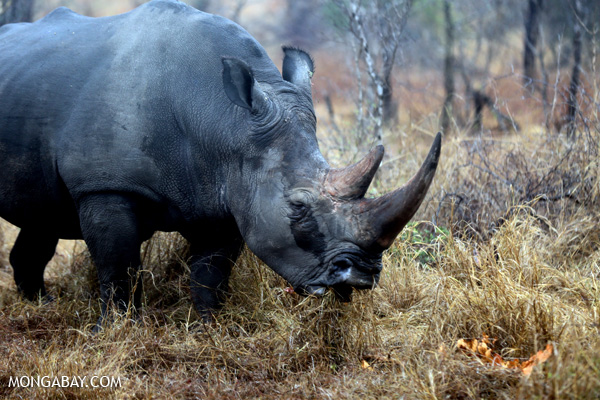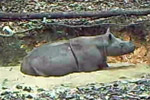In another sign that Africa’s poaching crisis has gotten completely out of control, South Africa lost 1,004 rhinos to poachers last year. According to the numbers released today by the South African Department of Environmental Affairs, 2013 was the worst year yet for rhino poaching in the country with nearly 3 rhinos killed every day.
South Africa is home to more rhinos than anywhere else in the world, making it a global target for rhino poachers. Rhinos are shot, their horns sawn off (often while still alive), and then left for dead. The horns are crushed into powder to meet the rising, illicit demand in East Asia for powdered rhino horn. Rhino horn consumers view the high-value powder as medicinal and increasingly a status symbol, however there is no evidence that rhino horn, which is made primarily of keratin, has any curative properties.
Tom Milliken, a rhino expert with TRAFFIC an anti-wildlife trading organization, says that South Africa’s rhinos are largely being decimated by poachers slipping in from Mozambique.

White rhino in South Africa. Photo by: Rhett A. Butler.
“South Africa and Mozambique must decisively up their game if they hope to stop this blatant robbery of southern Africa’s natural heritage,” he said in a statement. “2014 must mark the turning point where the world, collectively says ‘enough is enough’ and brings these criminal networks down. Rhino horn trafficking and consumption are not simply environmental issues, they represent threats to the very fabric of society.”
TRAFFIC says Mozambique must raise penalties for wildlife trade crimes, which is only a misdemeanor currently. The groups also calls on Vietnam, one of the major consuming countries of rhino horn, to make good on pledges to implement a tracking system to make sure rhino horns from trophy hunting don’t enter the black market. In many countries, trophy hunters are still allowed to kill rhinos for large fees and there have been several cases of such hunts being used to obtain and move rhino horn out of South Africa.
Experts say that South Africa’s rhino population is nearing a point where deaths outnumber births.
South Africa is home to two species of rhino, white rhinos (Ceratotherium simum) and black rhinos (Diceros bicornis). Most of those killed by poachers are white rhinos, simply because they are significantly more populous. White rhinos are currently listed as Near Threatened by the IUCN Red List, while the black rhino is considered Critically Endangered.
Related articles
Trophy hunters auction off life of Critically Endangered black rhino
(01/13/2014) The Dallas Safari Club has auctioned off a permit to shoot-and-kill a Critically Endangered black rhino in Namibia for $350,000. The club says the proceeds from the auction will aid rhino conservation, but the move has upset many wildlife organizations and attracted protestors outside the closed-door auction. In fact the issue has become so contentious that the FBI is currently investigating purported death threats against the Dallas Safari Club members over the issue. Currently, less than 5,000 black rhinos survive in the wild today, a drop of 90 percent since 1960 as the species has been decimated by poaching and habitat loss.
Requiem or recovery?: the Sumatran rhino 200 years after its description

(01/08/2014) In 1893, William Bell, a surgeon in the service of the Dutch East India Company stationed in Bencoolen, Sumatra, examined the body of a dead rhinoceros. The animal, a male, was relatively small as rhinoceroses go, measuring only four feet four inches at the shoulder and eight feet five inches from its nose to the tip of its tail. Dr. Bell noted that the animal resembled a large hog and judged it to be a young individual based upon the condition of the bones and teeth.
Consumer report uncovers why people buy rhino horn
(11/26/2013) The rhinoceros is one of the largest and most iconic animals to roam the earth. However, poaching for their horn, erroneously believed to have medicinal value, has led the IUCN Red List to classify three of the world’s five species as Critically Endangered. But, a new consumer report by the wildlife trade monitoring network, TRAFFIC, finds that rhino horn consumers in Vietnam buy the illegal product as much to raise their social status as to attempt to treat a fever or hangover.
New campaign: hey China, stop killing the ‘pandas of Africa’

(10/29/2013) A new public-service campaign in China will ask potential ivory and rhino horn buyers to see the victims of these illicit trades in a new light: as the “pandas of Africa.” The posters are a part of WildAid’s ‘Say No to Ivory and Rhino Horn’ campaign, which was launched earlier in the year.
790 rhinos poached in South Africa this year
(10/29/2013) 790 rhinos have been poached in South Africa this year, nearly a fifth higher than last year’s record toll, reports the Department of Environmental Affairs.
WWF risking Sumatran rhinos by releasing camera trap images, says scientist

(10/09/2013) On October 2nd, WWF released camera trap videos of Sumatran rhinos surviving in Kalimantan, Indonesian Borneo. The conservation organization had already announced in April that they had evidence of at least one Sumatran rhino in the province, but the new images confirmed what is likely to be a small surviving population. While this is good news for an animal on the edge of extinction, Erik Meijaard, a researcher who has worked in Indonesia for over 20 years, says WWF has made a mistake publicizing the news around the world, noting ‘the last thing those rhinos need is publicity.’
Unlikely success: how Zimbabwe has become a global leader in rhino conservation
![]()
(10/02/2013) With its collapsed economy, entrenched poverty, and political tremors, one would not expect that a country like Zimbabwe would have the capacity to safeguard its rhinos against determined and well-funded poachers, especially as just across the border South Africa is currently losing over two rhinos a day on average. And indeed, without the Lowveld Rhino Trust (LRT), rhinos in Zimbabwe would probably be near local extinction. But the LRT, which is centrally involved in the protection of around 90 percent of the country’s rhinos in private reserves along with conservancy members, has proven tenacious and innovative in its battle to safeguard the nation’s rhinos from the poaching epidemic.